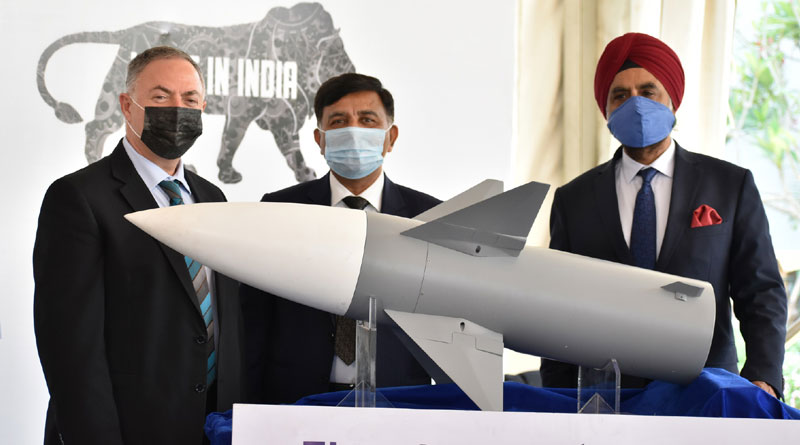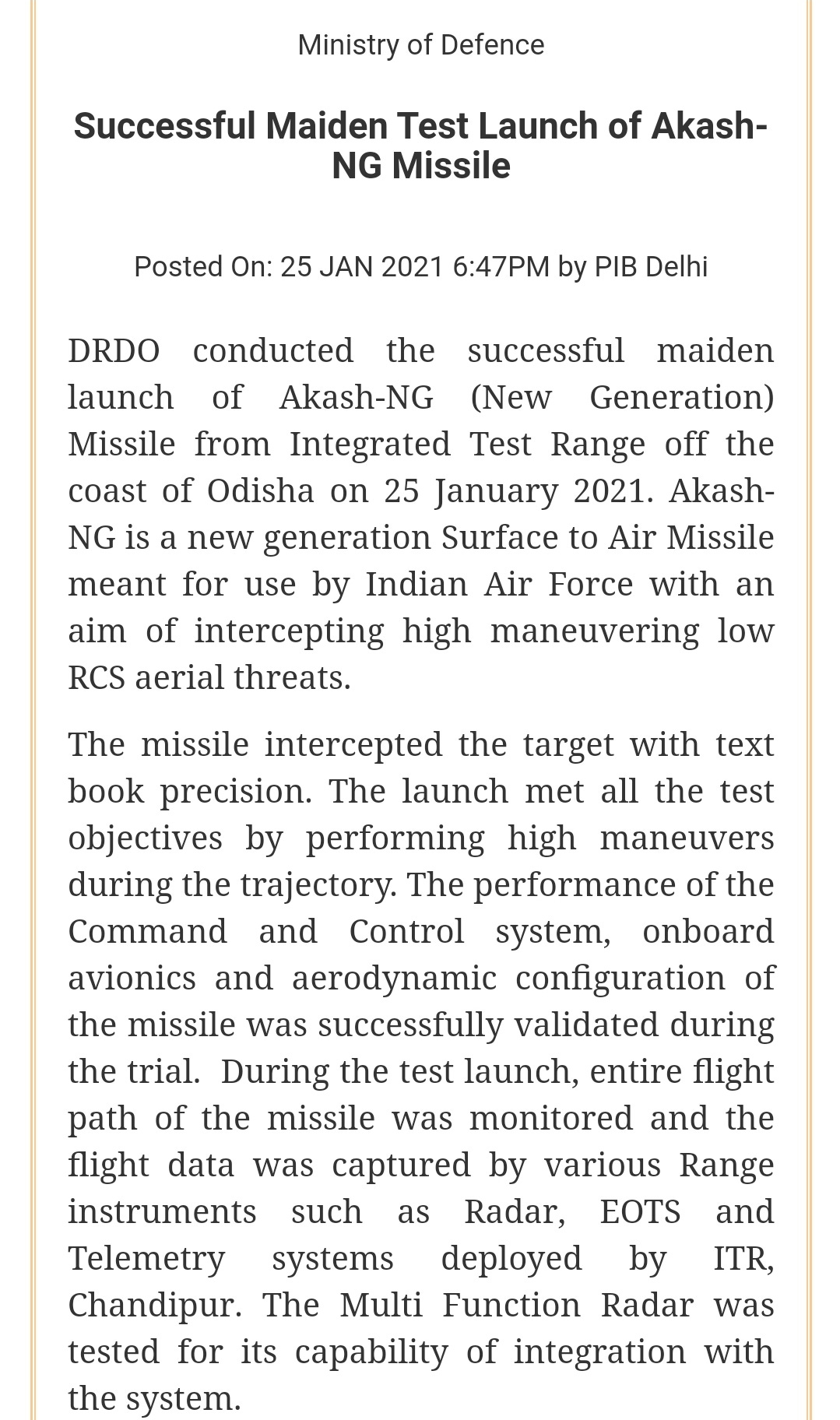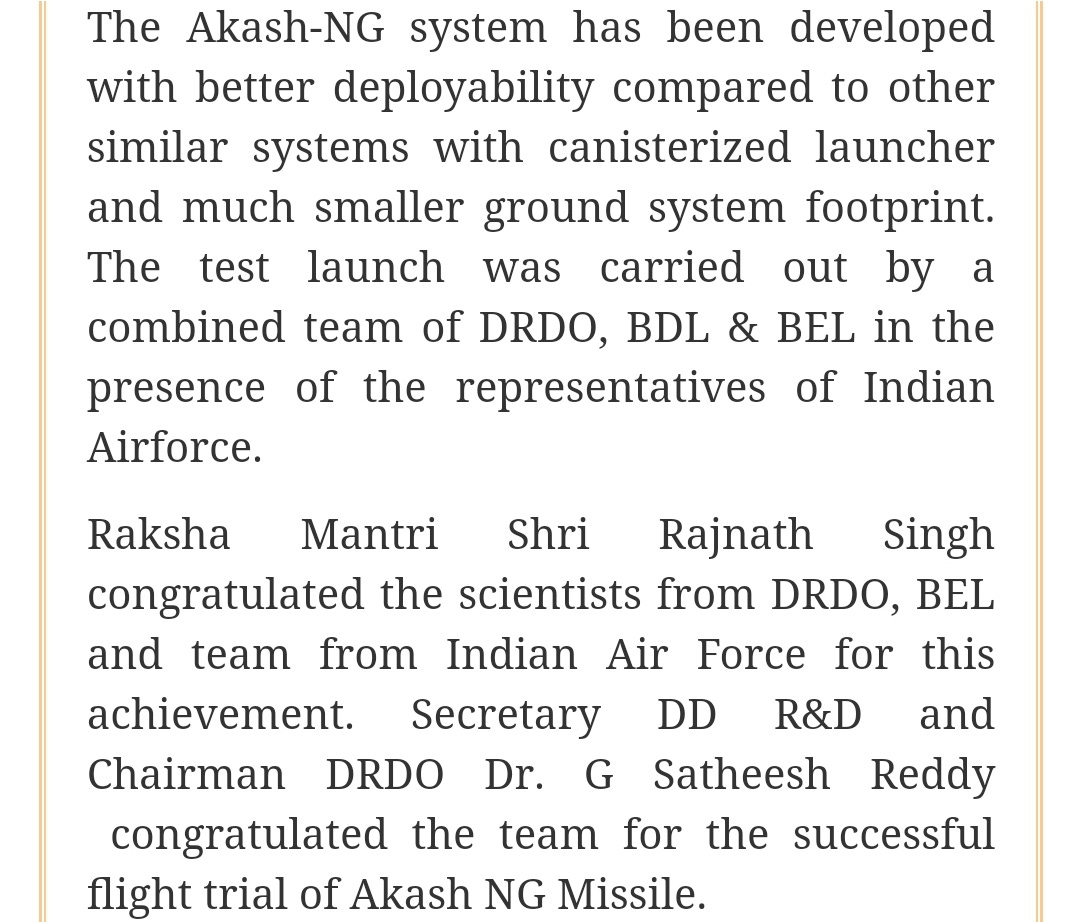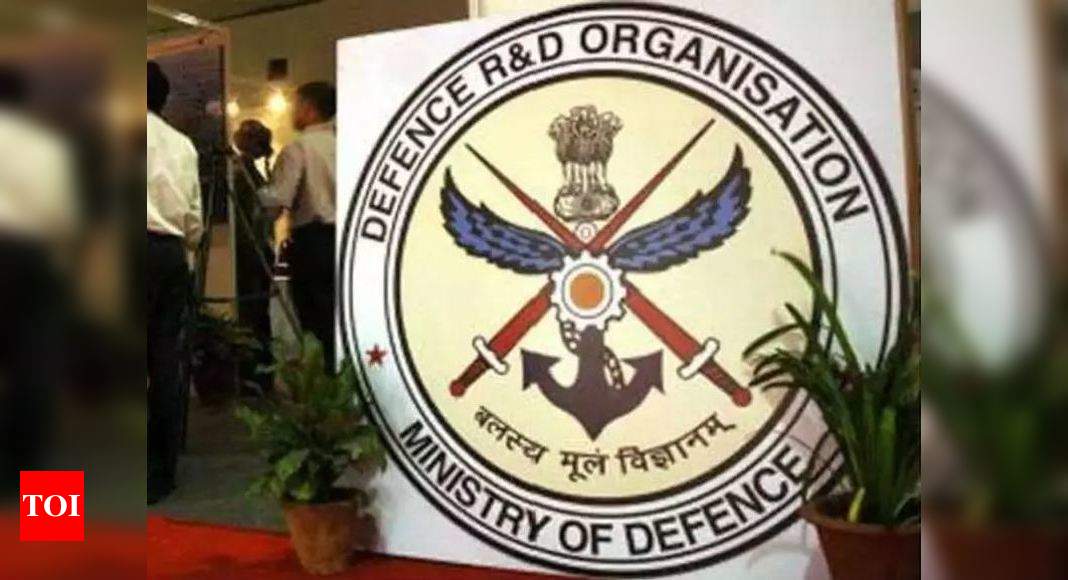You are using an out of date browser. It may not display this or other websites correctly.
You should upgrade or use an alternative browser.
You should upgrade or use an alternative browser.
Lightweight torpedo test-fired successfully from Navy’s Ilyushin Il-38 ASW
The indigenously-instrumented Advanced Light Torpedo (TAL), developed by the Naval Science and Technological Laboratory (NSTL), succesfully cleared its maiden flight trial with a parachute system from the Indian Navy’s Ilyushin Il-38 maritime patrol aircraft on Monday.
This was the country’s first such trial where the indigenous lightweight torpedo was fired from a fixed-wing aircraft.
The lightweight torpedo was designed, developed, produced and inducted into services a decade ago and is used against underwater platforms as part of anti-submarine warfare (ASW).
To enhance the range of quick acquisition of the target, the Navy scheduled the launch of TAL from fixed-wing aircraft of the Navy, for precise attacks at desired locations.
The torpedo, along with Torpedo Release Mechanism and Fire Control System, are designed and developed by the NSTL.
The torpedo, on safe separation from the aircraft, descends with the help of a parachute and the TRM detaches the parachute, enabling the torpedo to continue its operation in waters. The parachute is designed by ADRDE, Agra. The TAL can track multiple targets simultaneously using state-of-the-art processor-based signal processing algorithms.
The trial team, led by Principal Project Director R.V.S. Subrahmanyam and other members from NSTL and ADRDE Agra, participated in the trial along with the Indian Navy.
NSTL Director Dr O.R. Nandagopan congratulated the team and acknowledged the participation of the Indian Navy and other DRDO establishments such as ADRDE, ADE, and CEMILAC.

KRAS Rolls Out 1000 MRSAM Missile Kits for the Army, IAF
We are confident KRAS will not only build products for the Indian armed forces but will, at the same time, trigger and help achieve Indian government’s vision of exports from India
Kalyani Rafael Advanced Systems Pvt Ltd. (KRAS), a joint venture between India’s Kalyani Group and Israel’s Rafael Advanced Defense Systems rolled out the first batch of Medium Range Surface to Air Missile (MRSAM) for the Indian Army and the Indian Air Force (IAF).
A press statement from Kalyani Group stated, “The roll-out event marked KRAS’ commitment to deliver more than 1000 MRSAM ‘missile kits’ for the Indian Army and Air Force over the coming years. These missile sections will then be ‘forwarded’ to India’s state-run defence miniratna Bharat Dynamics Limited (BDL) for further and future integration.”
It added that the event designated the beginning of the journey of a MSME Indian company which is committed not only to the ‘Make-in-India’ concept, but to, as well, taking its own stride towards the larger ‘Atmanirbharta’ idea. In this effort the company has fused Rafael’s state-of the-art technology with the engineering excellence of the Kalyani Group.
The event was attended by officials from the Ministry of Defence, (MOD), Indian Army, Indian Air Force, DRDO, the BDL, and the Israeli delegation including EVP, Head of Air and Missile Defense Systems division of Rafael Brig. Gen. (Res.) Pinhas (Pini) Yungman. The Kalyani delegation was being led by President and CEO of BFL Defence Rajinder Bhatia and also by representatives from the IAI, Israel.
Chairman/ Managing Director, Kalyani Group, Baba Kalyani, said, “This is beginning of a new era, filled with self-confidence, a marked step-change in technological expertise and a collective demonstration of capability to be the global manufacturing hub for defence products. We are confident to complete the order far ahead of the stipulated time, and support the armed forces with the best in class missile kits. Apart from the missile kits, we will extend our support in Maintenance and Repair Operations (MRO) as in-service Air Defence Missile System for the armed forces.”
Speaking on the occasion, Head of Air and Missile Defense Systems division of Rafael Advanced Defense System, Brig. Gen. Pinhas Yungman, said, “We have been a reliable partner to the Indian armed forces for almost three decades, and these missile kits are a testimony of our commitment to ‘Make in India’ cause. We are confident KRAS will not only build products for the Indian armed forces but will, at the same time, trigger and help achieve Indian government’s vision of exports from India.”
@500

In Jan 2021, India tested its brand new Akash NG (New Generation) program. Name apart, this is a radically new system which overhauls the entire Akash architecture and has little resemblance to its predecessor. It offers the IAF a totally Indian replacement for the MRSAM joint venture (Barak-8 being the purely Israeli variant). The MRSAM depends on a high degree of imported subsystems like its radar and seeker, which can't be rapidly reconfigured without Israeli involvement. Judging by its revealed architecture and system details, the Akash NG will likely have equivalent or even better performance than the MRSAM. As can be expected, IAF representatives were present during the trial. The Akash NG features DRDO's dual pulse rocket motor too, a powerful seeker (approximately 2x the performance of that on the Astra Mk1, QRSAM), and is specifically tailored for low Radar Cross Section threats. The threat class also indicates it will field DRDO's new laser fuse. Intercepting highly maneuvering targets is where the Dual Pulse motor will be particularly useful. The seeker can target velocities up to the SRBM class clearly indicating a limited TMD role, similar to that of the Barak-8. Considering a missile/ rocket barrage is an increasing threat for many forward IAF bases, this is a useful capability to have.
Unlike the MRSAM, this is not a vertical launch system. There are tradeoffs here. On the one hand the missile need not carry excess weight in the form of thrust vector control or a nose cone with motors to slew it (Brahmos style, and which would impede lock on before launch), implying better range. A slant /turntable mechanism would give it better reaction times too. However dealing with multi axis surge attacks would be a challenge unless DRDO had each launcher address a sector independently. This is exactly what they have done.
(More at link)
F
FalconSlayersDFI
Guest
Boeing has also announced that this type of flying torpedo add-on kits(High Altitude Anti-Submarine Warfare Weapon Capability (HAAWC)). We 'll wait and see if it will be an effective ammunition or not.
F
FalconSlayersDFI
Guest
It will be a force multiplier as now Indian Navy can use Andaman and Nicobar Islands with true potential, I feel a dedicated Naval Tejas Aircrafts which can carry these torpedoes should pe separately procured for Non carrier based ops from Ground with these torpedoes.Boeing has also announced that this type of flying torpedo add-on kits(High Altitude Anti-Submarine Warfare Weapon Capability (HAAWC)). We 'll wait and see if it will be an effective ammunition or not.
F
FalconSlayersDFI
Guest
They can only do production, not such R&D stuff. If they had to they would have been doing it.Outsource it to Tata or L&T. DRDO can't manage timelines.
Earlier they weren't allowed. Now they areThey can only do production, not such R&D stuff. If they had to they would have been doing it.
F
FalconSlayersDFI
Guest
They aren’t working on systems, better they first provide a suitable Small arms system to Indian Armed Forces.Earlier they weren't allowed. Now they are
There's no N-Tejas anymore. It's only gonna be the TEDBF until ADA comes up with a Naval variant for the AMCAIt will be a force multiplier as now Indian Navy can use Andaman and Nicobar Islands with true potential, I feel a dedicated Naval Tejas Aircrafts which can carry these torpedoes should pe separately procured for Non carrier based ops from Ground with these torpedoes. View attachment 16678
F
FalconSlayersDFI
Guest
The one that was a prototype can be used as a limited series production aircraft, 2 squadrons of NLCA is a good option for non-carrier based ops.There's no N-Tejas anymore. It's only gonna be the TEDBF until ADA comes up with a Naval variant for the AMCA
That'll take up significant time and resources since IN would want a full fledged aircraft with an IOC. ADA has it's hands full with MWF, TEDBF and AMCA. This will also take up the production line since 2 squadrons for IAF is 36 aircrafts which takes 3-4yrs to produce straining an already over-burdened assembly line. Even with LCA's new line, the production is only going upto 16 aircraft per yr. Additionally, production of N-LCA might require changes to the assembly lineThe one that was a prototype can be used as a limited series production aircraft, 2 squadrons of NLCA is a good option for non-carrier based ops.
In Jan 2021, India tested its brand new Akash NG (New Generation) program. Name apart, this is a radically new system which overhauls the entire Akash architecture and has little resemblance to its predecessor. It offers the IAF a totally Indian replacement for the MRSAM joint venture (Barak-8 being the purely Israeli variant). The MRSAM depends on a high degree of imported subsystems like its radar and seeker, which can't be rapidly reconfigured without Israeli involvement. Judging by its revealed architecture and system details, the Akash NG will likely have equivalent or even better performance than the MRSAM. As can be expected, IAF representatives were present during the trial. The Akash NG features DRDO's dual pulse rocket motor too, a powerful seeker (approximately 2x the performance of that on the Astra Mk1, QRSAM), and is specifically tailored for low Radar Cross Section threats. The threat class also indicates it will field DRDO's new laser fuse. Intercepting highly maneuvering targets is where the Dual Pulse motor will be particularly useful. The seeker can target velocities up to the SRBM class clearly indicating a limited TMD role, similar to that of the Barak-8. Considering a missile/ rocket barrage is an increasing threat for many forward IAF bases, this is a useful capability to have.
Unlike the MRSAM, this is not a vertical launch system. There are tradeoffs here. On the one hand the missile need not carry excess weight in the form of thrust vector control or a nose cone with motors to slew it (Brahmos style, and which would impede lock on before launch), implying better range. A slant /turntable mechanism would give it better reaction times too. However dealing with multi axis surge attacks would be a challenge unless DRDO had each launcher address a sector independently. This is exactly what they have done.

Take a quick look at the image above after reading the press release. What you see is India's first combined Radar and Launcher setup beyond the short range Trishul program. The image clearly shows a 4 panel AESA Multi Function radar setup, similar to that developed for the QRSAM program.
Towards the rear, behind the initial smoke plume, you can see another slanted panel. So 360 degree coverage, with the thinner strip panels for IFF. The radar in all likelihood will be more powerful than that on the QRSAM. It has to be, as the Akash NGs envelope will be around 2.5-3x that of the QRSAM’s. The radar has to look and guide further.
In short, unless this is a test setup alone (which doesn't seem likely, why go to all that trouble for this configuration) each Akash NG can have an independent battery by itself, mobile and lethal. It can relocate on its own and unlike comparable Russian systems, the radar is fully multi-function with limited dependence on its Surveillance Radar beyond Early Warning. It is also AESA, something the Russians are yet to broadbase on their SAM systems.
Given the radars capacity, it wouldn't be beyond DRDO to pair this radar with independent launchers too. They'd complement the units with the radar-missile mix. Perhaps, operating as launchers plus loaders with spare missiles.
All in all, there are many interesting possibilities in play if DRDO chooses to go ahead with this configuration.
We can also expect future variants of this radar to have an EO pod with a long range thermal Imager, day camera and a long range laser finder as a back up to the radar allowing it to mount nearly undetectable attacks (very few fighters have laser warning systems). Again, similar to the QRSAM system.
While colocating the radar and missiles may open up their vulnerability to Anti Radiation Missiles, these are AESA systems, not easy to track or counter. Remote operation would be possible and knocking out a radar merely takes one launcher off the table. In the MRSAM architecture, unless there are backups, the single radar is the key FCR for its launchers. With the Akash NG, targeting a single radar is not enough to shut down a multi-launcher threat, each with its own sensors.
In short, this is a much more lethal system. And all this in a compact footprint as DRDO notes.

In the next iteration we will likely see the Akash NGs AESA Based long range surveillance radar too. Via a command post the whole setup will be linked to the IAFs IACCS, with engagement efficacy being dramatically boosted by access to the IAFs wider sensor network.
Overall, the Akash NG program offers India a very capable and credible alternative to reliance on imported systems, which come with more restrictions and can't be rapidly reconfigured to Indian requirements. The IAF would be well served to induct it, and have DRDO develop more variants for enhanced range profiles and threat classes.

Unlike the MRSAM, this is not a vertical launch system. There are tradeoffs here. On the one hand the missile need not carry excess weight in the form of thrust vector control or a nose cone with motors to slew it (Brahmos style, and which would impede lock on before launch), implying better range. A slant /turntable mechanism would give it better reaction times too. However dealing with multi axis surge attacks would be a challenge unless DRDO had each launcher address a sector independently. This is exactly what they have done.

Take a quick look at the image above after reading the press release. What you see is India's first combined Radar and Launcher setup beyond the short range Trishul program. The image clearly shows a 4 panel AESA Multi Function radar setup, similar to that developed for the QRSAM program.
Towards the rear, behind the initial smoke plume, you can see another slanted panel. So 360 degree coverage, with the thinner strip panels for IFF. The radar in all likelihood will be more powerful than that on the QRSAM. It has to be, as the Akash NGs envelope will be around 2.5-3x that of the QRSAM’s. The radar has to look and guide further.
In short, unless this is a test setup alone (which doesn't seem likely, why go to all that trouble for this configuration) each Akash NG can have an independent battery by itself, mobile and lethal. It can relocate on its own and unlike comparable Russian systems, the radar is fully multi-function with limited dependence on its Surveillance Radar beyond Early Warning. It is also AESA, something the Russians are yet to broadbase on their SAM systems.
Given the radars capacity, it wouldn't be beyond DRDO to pair this radar with independent launchers too. They'd complement the units with the radar-missile mix. Perhaps, operating as launchers plus loaders with spare missiles.
All in all, there are many interesting possibilities in play if DRDO chooses to go ahead with this configuration.
We can also expect future variants of this radar to have an EO pod with a long range thermal Imager, day camera and a long range laser finder as a back up to the radar allowing it to mount nearly undetectable attacks (very few fighters have laser warning systems). Again, similar to the QRSAM system.
While colocating the radar and missiles may open up their vulnerability to Anti Radiation Missiles, these are AESA systems, not easy to track or counter. Remote operation would be possible and knocking out a radar merely takes one launcher off the table. In the MRSAM architecture, unless there are backups, the single radar is the key FCR for its launchers. With the Akash NG, targeting a single radar is not enough to shut down a multi-launcher threat, each with its own sensors.
In short, this is a much more lethal system. And all this in a compact footprint as DRDO notes.

In the next iteration we will likely see the Akash NGs AESA Based long range surveillance radar too. Via a command post the whole setup will be linked to the IAFs IACCS, with engagement efficacy being dramatically boosted by access to the IAFs wider sensor network.
Overall, the Akash NG program offers India a very capable and credible alternative to reliance on imported systems, which come with more restrictions and can't be rapidly reconfigured to Indian requirements. The IAF would be well served to induct it, and have DRDO develop more variants for enhanced range profiles and threat classes.

I posted here already before: https://defencehub.live/threads/indian-missile-archive.91/page-9#post-62473
"Firestarter" will be interesting blog to follow.
"Firestarter" will be interesting blog to follow.
Huge news guys:

 timesofindia.indiatimes.com
timesofindia.indiatimes.com
NEW DELHI: In a bid to promote the domestic defence industry, the Defence Research and Development Organisation
(DRDO) has allowed private sector firms to both develop and produce missile systems such as vertical launched surface to air missile systems programme.
"Under the Development cum Production Partner (DCPP) programme, we have allowed the private sector to co-develop missile systems with us and then also produce them," senior DRDO officials told ANI.
"Private sector firms have responded very enthusiastically for participation and bids have been received for the Vertically-launched Short-range Surface to Air Missile system (VL-SRSAM) project," they said.
The effort is part of initiatives to prepare the private sector industry to be able to develop complex military systems under the Make in India project of the Narendra Modi government.
The all-weather air defence missile system is being developed to provide point and area defence against various aerial targets like jets, fighter aircraft, unmanned aerial vehicles.
The canister-based state of art weapon system would be able to identify, track, engage and destroy the target with a high kill probability. It has a strike range of about 40 km.
The DRDO has also helped private sector industry including Tata and Baba Kalyani industries to develop the ATAGS howitzer which is likely to be the main artillery gun for the Indian Army in the next many decades.
============================================================

DRDO opens up missile production partnership for Indian private sector | India News - Times of India
India News: In a bid to promote the domestic defence industry, the Defence Research and Development Organisation(DRDO) has allowed private sector firms to both de
NEW DELHI: In a bid to promote the domestic defence industry, the Defence Research and Development Organisation
(DRDO) has allowed private sector firms to both develop and produce missile systems such as vertical launched surface to air missile systems programme.
"Under the Development cum Production Partner (DCPP) programme, we have allowed the private sector to co-develop missile systems with us and then also produce them," senior DRDO officials told ANI.
"Private sector firms have responded very enthusiastically for participation and bids have been received for the Vertically-launched Short-range Surface to Air Missile system (VL-SRSAM) project," they said.
The effort is part of initiatives to prepare the private sector industry to be able to develop complex military systems under the Make in India project of the Narendra Modi government.
The all-weather air defence missile system is being developed to provide point and area defence against various aerial targets like jets, fighter aircraft, unmanned aerial vehicles.
The canister-based state of art weapon system would be able to identify, track, engage and destroy the target with a high kill probability. It has a strike range of about 40 km.
The DRDO has also helped private sector industry including Tata and Baba Kalyani industries to develop the ATAGS howitzer which is likely to be the main artillery gun for the Indian Army in the next many decades.
============================================================





